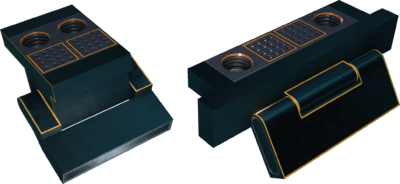Difference between revisions of "Hinges"
m (Text replacement - "|availability=Luxury Items" to "") |
|||
| (22 intermediate revisions by 9 users not shown) | |||
| Line 1: | Line 1: | ||
{{Otherlang2 | {{Otherlang2 | ||
|ru=Шарниры | |ru=Шарниры | ||
}} | |||
== Summary == | |||
}} | <br> | ||
<br> | |||
[[File:Starbase_devices_hinges.png|400px]] | |||
<br> | |||
<br> | |||
Hinges are devices used for creating turning, sliding and opening mechanisms such as doors, hatches and sliding doors. | |||
== Basic information == | == Basic information == | ||
Hinges are | Hinges are commonly interacted with by controlling it via a [[Buttons|button]] or [[YOLOL|YOLOL]] script.<br> | ||
A hinge's DoorOpenState-field can be connected to a button.<br> | |||
The button can be then used to remotely open or close the hinge. | |||
< | <br> | ||
There are currently 16 different hinges however they all share the same operation they are either a fold/unfold or a sliding hinge. The majority of the variety is taken up by fold/unfolding hinges. A major issue with hinges when making ships is that they do not pass on electricity or signals. some variants can get past this, however. Hinges are also said to be weak to pressure so like turntables it would be a bad idea to mount thrusters to them. | |||
[[File:space-13_57_44.png|400px]] | |||
[[File:space-13_33_27.png|400px]] | |||
== Device fields == | |||
To learn more about how to use fields, consult these wiki pages: | |||
* [[Universal tool|Universal Tool]] | |||
* [[Data networks|Data networks]] | |||
* [[YOLOL|YOLOL]] | |||
{|class="wikitable" | {|class="wikitable" | ||
| Line 198: | Line 43: | ||
| [0,1] | | [0,1] | ||
|- | |- | ||
! ''' | ! '''EndRotation / EndPosition''' | ||
| The rotation/position the joint should be at when ''DoorOpenState'' is 1. Is measured in percents(%) relative to the maximum possible open state for prismatic joints, and degrees in hinge joints. | | The rotation/position the joint should be at when ''DoorOpenState'' is 1. Is measured in percents(%) relative to the maximum possible open state for prismatic joints, and degrees in hinge joints. | ||
| | | | ||
|- | |- | ||
!''' | !'''StartRotation / StartPosition''' | ||
| The rotation/position the joint should be at when ''DoorOpenState'' is 0. Is measured in percents(%) relative to the maximum possible open state for prismatic joints, and degrees in hinge joints. | | The rotation/position the joint should be at when ''DoorOpenState'' is 0. Is measured in percents(%) relative to the maximum possible open state for prismatic joints, and degrees in hinge joints. | ||
| | | | ||
| Line 211: | Line 56: | ||
|} | |} | ||
<!-- joint motors --> | |||
[[Category:Devices and machines|Hinges]] | [[Category:Devices and machines|Hinges]] | ||
Revision as of 11:53, 6 February 2020
Summary

Hinges are devices used for creating turning, sliding and opening mechanisms such as doors, hatches and sliding doors.
Basic information
Hinges are commonly interacted with by controlling it via a button or YOLOL script.
A hinge's DoorOpenState-field can be connected to a button.
The button can be then used to remotely open or close the hinge.
There are currently 16 different hinges however they all share the same operation they are either a fold/unfold or a sliding hinge. The majority of the variety is taken up by fold/unfolding hinges. A major issue with hinges when making ships is that they do not pass on electricity or signals. some variants can get past this, however. Hinges are also said to be weak to pressure so like turntables it would be a bad idea to mount thrusters to them.
Device fields
To learn more about how to use fields, consult these wiki pages:
| YOLOL field | Description | Range |
|---|---|---|
| DoorOpenState | Input field for requested door state. 0 is closed, 1 is fully open. | [0,1] |
| DoorCurrentState | Reports the current position of the door, on the same scale as DoorOpenState | [0,1] |
| EndRotation / EndPosition | The rotation/position the joint should be at when DoorOpenState is 1. Is measured in percents(%) relative to the maximum possible open state for prismatic joints, and degrees in hinge joints. | |
| StartRotation / StartPosition | The rotation/position the joint should be at when DoorOpenState is 0. Is measured in percents(%) relative to the maximum possible open state for prismatic joints, and degrees in hinge joints. | |
| TargetVelocity | The maximum velocity the joint will reach. Different joint devices have different velocity limits, and might not be able to reach the configured velocity. |
